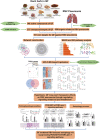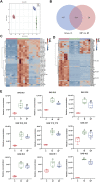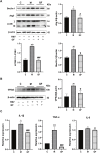Integrated Network Pharmacology and Lipidomics to Reveal the Inhibitory Effect of Qingfei Oral Liquid on Excessive Autophagy in RSV-Induced Lung Inflammation
- PMID: 34925035
- PMCID: PMC8672039
- DOI: 10.3389/fphar.2021.777689
Integrated Network Pharmacology and Lipidomics to Reveal the Inhibitory Effect of Qingfei Oral Liquid on Excessive Autophagy in RSV-Induced Lung Inflammation
Abstract
Background: Respiratory syncytial virus (RSV) can cause varying degrees of lung inflammation in children. Qingfei Oral Liquid (QF) is effective in treating childhood RSV-induced lung inflammation (RSV-LI) in clinics, but its pharmacological profiles and mechanisms remain unclear. Methods: This study combined network Pharmacology, lipidomics, pharmacodynamics, and pathway validation to evaluate the therapeutic mechanisms of QF. Using Cytoscape (v3.8.2) and enrichment analyses from the Kyoto Encyclopedia of Genes and Genomes (KEGG) and Gene Ontology (GO), a global view of the putative compound-target-pathway network was created. The corresponding lipidomic profiles were then used to detect differently activated lipids, revealing the metabolic pathway, using ultra-high-performance liquid chromatography linked to hybrid Quadrupole-Exactive Orbitrap mass spectrometry (UHPLC-Q-Exactive Orbitrap MS). Meanwhile, the in vivo efficiency of QF, the enrichment pathway, and the excessive autophagy inhibition mechanisms were validated in RSV-infected mice models. Results: The network pharmacology results demonstrated 117 active compounds acted directly upon 101 core targets of QF against RSV-LI. The most significantly enriched pathway was the PI3K/Akt/mTOR signaling pathway (p < 0.05). In addition, untargeted lipidomics were performed, and it was revealed that higher lung levels of DAG 30:0, DAG 30:5, DAG 32:0, DAG 16:0_18:0, DAG 17:0_17:0, DAG 34:1, DAG 36:0, DAG 36:1 in the RSV-LI group were decreased after QF administration (FDR < 0.05, FC > 1.2). Lipin-1, a key enzyme in DAG synthesis, was increased in the RSV-LI mouse model. Animal experiments further validated that QF inhibited the PI3K/Akt/mTOR signaling pathway, with lower lung levels of phosphorylated PI3K, AKT and mTOR, as well as its related proteins of lipin-1 and VPS34 (p < 0.01). Finally, pharmacodynamic investigations indicated that QF reduced airway inflammation caused by excessive autophagy by decreasing lung levels of RSV F and G proteins, Beclin-1, Atg5, and LC3B II, IL-1 and TNF-α (p < 0.05). Conclusion: Lipidomic-based network pharmacology, along with experimental validation, may be effective approaches for illustrating the therapeutic mechanism of QF in the treatment of RSV-LI.
Keywords: PI3K/AKT/mTOR; excessive autophagy; lipidomics; lipin-1; network pharmacology; qingfei oral liquid; respiratory syncytial virus.
Copyright © 2021 Lin, An, Chen, Feng, Lu, Liu, Chu, Shan, Xie, Wang and Wang.
Conflict of interest statement
The authors declare that the research was conducted in the absence of any commercial or financial relationships that could be construed as a potential conflict of interest.
Figures








Similar articles
-
Qingfei oral liquid inhibited autophagy to alleviate inflammation via mTOR signaling pathway in RSV-infected asthmatic mice.Biomed Pharmacother. 2021 Jun;138:111449. doi: 10.1016/j.biopha.2021.111449. Epub 2021 Mar 8. Biomed Pharmacother. 2021. PMID: 33706133
-
Qingfei oral liquid alleviates RSV-induced lung inflammation by promoting fatty-acid-dependent M1/M2 macrophage polarization via the Akt signaling pathway.J Ethnopharmacol. 2022 Nov 15;298:115637. doi: 10.1016/j.jep.2022.115637. Epub 2022 Aug 12. J Ethnopharmacol. 2022. PMID: 35970312
-
Qingfei Formula Protects against Human Respiratory Syn cytial Virus-induced Lung Inflammatory Injury by Regulating the M APK Signaling Pathway.Comb Chem High Throughput Screen. 2024;27(7):969-983. doi: 10.2174/1386207326666230821121358. Comb Chem High Throughput Screen. 2024. PMID: 37605417 Free PMC article.
-
Network pharmacology, molecular docking, and untargeted metabolomics reveal molecular mechanisms of multi-targets effects of Qingfei Tongluo Plaster improving respiratory syncytial virus pneumonia.Chin Herb Med. 2024 Jul 29;16(4):638-655. doi: 10.1016/j.chmed.2024.07.007. eCollection 2024 Oct. Chin Herb Med. 2024. PMID: 39606255 Free PMC article.
-
A network pharmacology approach and experimental validation to investigate the anticancer mechanism and potential active targets of ethanol extract of Wei-Tong-Xin against colorectal cancer through induction of apoptosis via PI3K/AKT signaling pathway.J Ethnopharmacol. 2023 Mar 1;303:115933. doi: 10.1016/j.jep.2022.115933. Epub 2022 Nov 18. J Ethnopharmacol. 2023. PMID: 36403742
Cited by
-
Study on the mechanism of Xanthoceras sorbifolia Bunge oil in the treatment of Alzheimer's disease by an integrated "network pharmacology-metabolomics" strategy.Ann Med. 2025 Dec;57(1):2499700. doi: 10.1080/07853890.2025.2499700. Epub 2025 May 8. Ann Med. 2025. PMID: 40340504 Free PMC article.
-
Early potential metabolic biomarkers of T1 stage lung adenocarcinoma based on serum metabolomics.Front Mol Biosci. 2025 Apr 25;12:1544774. doi: 10.3389/fmolb.2025.1544774. eCollection 2025. Front Mol Biosci. 2025. PMID: 40351532 Free PMC article.
-
Fuzhengjiedu San inhibits porcine reproductive and respiratory syndrome virus by activating the PI3K/AKT pathway.PLoS One. 2024 May 6;19(5):e0283728. doi: 10.1371/journal.pone.0283728. eCollection 2024. PLoS One. 2024. PMID: 38709810 Free PMC article.
-
Autophagy and Respiratory Viruses: Mechanisms, Viral Exploitation, and Therapeutic Insights.Cells. 2025 Mar 12;14(6):418. doi: 10.3390/cells14060418. Cells. 2025. PMID: 40136667 Free PMC article. Review.
-
Acteoside attenuates RSV-induced lung injury by suppressing necroptosis and regulating metabolism.Front Pharmacol. 2022 Aug 19;13:870928. doi: 10.3389/fphar.2022.870928. eCollection 2022. Front Pharmacol. 2022. PMID: 36059973 Free PMC article.
References
LinkOut - more resources
Full Text Sources
Miscellaneous

